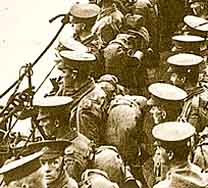|
|
 |
.gif)
.gif)  |
.gif) |
 |
.gif)
The attack on Gallipoli was one of the more
imaginative strategies of the First World War.

The German army had delivered a crushing
blow to Russia at Tannenberg at the start of the war and
had been driving eastwards. The Russians were threatened
by a Turkish advance through the Caucasus and appealed
to their allies for assistance. Gaining control of the
Dardanelles would re-establish communications with
Russia and release wheat and shipping locked in the
Black Sea by Turkey. | |
.gif) |

Besides this, British strategists had for many
years before the war believed that the best defence of Egypt
and the Suez Canal was an attack on Turkey.

The British Royal Navy could have gone a long way
towards achieving these goals by steaming through the
Dardanelles straits in November 1914 and shelling
Constantinople (now Istanbul) and perhaps putting the
government to flight. Instead, they cautiously tested the
range of the Turkish guns by bombarding the shore
batteries.

The Turkish commanders immediately became aware of
their vulnerability to further attacks and strengthened their
defences to include carefully laid minefields, well-sited guns
and searchlights that swept the narrows at night.

Three months later, a British and French fleet
that included 18 battleships, attempted to force its way
through to Constantinople. Three capital ships were lost and
three crippled.

Unknown to the Allies, the Turkish gun batteries
had almost exhausted their ammunition supplies in this effort,
and the fleet could have sailed on through the straits with
little further damage. Instead, the naval commanders came to
the conclusion that they could not force their way through the
Dardanelles unless troops were first sent to occupy the
Gallipoli Peninsula in force to silence the Turkish guns.
Planning for the landing of troops on Gallipoli commenced.
 |
| |
|